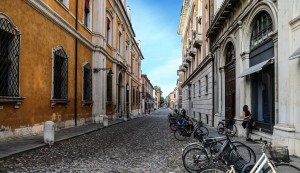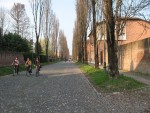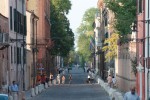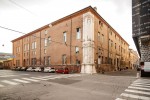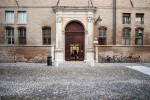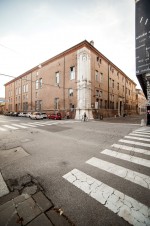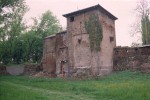Corso Ercole I d'Este
This important Renaissance road connects Porta degli Angeli gate on the northern section of the city walls (where Rampari di Belfiore meets Via Orlando Furioso) with Castello Estense.
Name and brief history
Corso Ercole I d’Este is one of the most famous streets in Ferrara, known for its beauty and because it is an essential part of the Erculean Addition, the revolutionary urban development project conceived of by Duke Ercole I d'Este and his architect Biagio Rossetti between the late fifteenth century and the early sixteenth century. It was what earned Ferrara the title of 'first modern city in Europe’, resulting in its addition to the UNESCO World Heritage List in 1995, with the title of ‘Renaissance City’. That recognition was then extended in 1999 to the entire Po Delta and the noble residences known as the Delizie Estensi, creating the present-day ‘Ferrara, City of the Renaissance, and its Po Delta’ UNESCO site.
Now named after the duke who built the entire neighbourhood, this street was previously named Corso Vittorio Emanuele, and before that, Via Piopponi and Via degli Angeli. The section extending between Palazzo dei Diamanti and Castello Estense was called Via dello Scorsuro.
Corso Ercole I d’Este is almost entirely residential. The only exception is the shop window of a business on the corner with Largo Castello and, in the section next to the walls, a restaurant.
Travelling down the road, one comes across different historically and architecturally important buildings. Departing from the castle, to the left is the former Monte di Pietà building and, at the corner with Via Armari, is the recently-restored Palazzo Gulinelli, the headquarters of the Canonici Mattei Institute from post-WWII until 2011, now the Smiling International School, preceded by the Museum of the Risorgimento and Resistance at n. 19. On the opposite side, at n. 18 (in the Don Giulio d’Este building) is the headquarters of the Prefecture and the Prefect's residence.
At the main intersection (where Corso Ercole I d’Este meets Corso Biagio Rossetti heading west and Corso Porta Mare heading east) is the Quadrivio degli Angeli (Crossroads of Angels), the heart of the Erculean Addition. Some of the city's most important, prestigious buildings look out over it: Palazzo dei Diamanti at n. 21, currently the Contemporary Art Museum and, on the main floor, the National Painting Gallery; Palazzo Turchi-Di Bagno at n. 32, currently the University's Department of Biology and Evolution; Palazzo Prosperi-Sacrati at n. 23, owned by the Municipality since 1997, which has been remodelled multiple times over the years and was damaged when bombed by the Allied forces, awaiting its future use as part of the Ferrara Museum System (€6 million were allocated for its restoration in 2018), but which continues to stand out for its wonderful portal, restored by architect Enrico Alessandri. Facing Palazzo Prosperi-Sacrati is the Central Police Station of Ferrara (Caserma Bevilacqua), beyond which is the side entrance of Parco Massari.
Continuing down the street, at the intersection with Via Arianuova, are Palazzo Trotti-Mosti at n. 37, and, at n. 44, Palazzo Guarini-Giordani, both of which are part of the University's Law Department. Palazzo Guarini-Giordani is also the head office of the Centre for European Studies.
Designed by Adamo and Sesto Boari in the 1920s, Palazzina degli Angeli is found at 47-51 Corso Ercole I d’Este. It stands on a plot of land once occupied by the old convent of Santa Maria degli Angeli, which is mentioned in a special commemorative plaque. In 1984, it became the home/studio to an architect named Zappaterra, following a restoration that integrated the pre-existing decorative elements with postmodern ones.
The avenue ends at Porta degli Angeli, ‘which almost exclusively was used by the princes and nobles of the ducal court going to hunt in Parco Belfiore’ (G. Melchiorri, Nomenclatura ed Etimologia delle Piazze e delle Strade di Ferrara e Ampliamenti all’Opera di Gerolamo Melchiorri, edited by C. Bassi, 2G Editrice, Ferrara 2009, p. 165). This ‘gate of honour’ was a place of passage for important figures such as Henry III of France in 1574, or Albert VII, Archduke of Austria with his niece Margaret and her mother in 1598.
In literature
One of the most famous portrayals of Corso Ercole I d’Este is, without a doubt, that penned by Giorgio Bassani in his most celebrated novel, The Garden of the Finzi-Continis.
In a continuous back-and-forth between real and imaginary, Bassani in some way warns ‘the poor tourists’ that there is nothing special about the garden - in the narrative of the story because nothing has remained, in reality because very little or nothing of it ever existed. His daughter, Paola Bassani, explained: ‘My father loved paradoxes and sometimes embodied them. I realised that the garden so intrinsically linked to his most famous novel is not, as one might believe from the pages of his book, in Corso Ercole I d’Este, in the heart of the city, but hundreds of kilometres from Ferrara, in Ninfa. It’s a property owned by the royal Caetani siblings, Roffredo and Marguerite. The latter was the director of Botteghe Oscure, a magazine that my father worked for at length. ...My father was deeply struck and fascinated by the Gardens of Ninfa, to the point that he internalised the gardens for many years, then dropped them in Ferrara, or I should say, he had the courage to drop them in Ferrara. That’s right. He who said he was a crusader, wanting to talk about Ferrara and its historical and topographical reality, put the Gardens of Ninfa in the city of Ferrara! As he said in an interview, he allowed himself this rather large transgression: “I took a few liberties”, he said, and then provided Ninfa as an example’. (P. Bassani, Se Avessi una Piccola Casa Mia. Giorgio Bassani, il Racconto di una Figlia, La nave di Teseo, Milan 2016, p. 29s.)
Nevertheless, the allure of a garden that doesn’t exist continues to draw literary tourists from around the world to this street in Ferrara. Even without the garden, they are satisfied by the beauty of Corso Ercole I d’Este, its buildings and atmosphere.
Giosuè Carducci also mentioned a few of the most important buildings of Corso Ercole I d’Este in a poem titled Alla Città di Ferrara.
In film
Corso Ercole I d’Este, with Palazzo Prosperi-Sacrati, was immortalised by Michelangelo Antonioni in Story of a Love Affair (1950) and in Beyond the Clouds (1995).
Quotes
Who knows from what, and why, a vocation for solitude is born. The fact remains that the same isolation, the very separateness with which the Finzi-Continis surrounded their deceased, also surrounded the other house they owned, the one at the end of Corso Ercole I d’Este. Immortalized by Giosuè Carducci and Gabriele D’Annunzio, this Ferrara street is so well known to lovers of art and poetry the world over that any description of it would only be superfluous. As is well known, it is in the very heart of that northern zone of the city which the Renaissance added to the cramped medieval quarters, and which for that reason is called the Addizione Erculea. Broad, straight as a sword from the Castle to the Mura degli Angeli, flanked its whole length by the sepia bulk of upper-class residences, with its distant, sublime backdrop of red bricks, green vegetation and sky, which really seems to lead you on towards the infinite: Corso Ercole I d’Este is so handsome, such is its touristic renown, that the joint Socialist-Communist administration, responsible to the Ferrara Council for more than fifteen years, has recognized the obligation to leave it be, to defend it against any and every possible disruption by speculative building or commercial interests, in short to conserve the whole original aristocratic character of the place. It is a famous street: and what is more, it remains effectively undisturbed. All the same, with particular reference to the Finzi-Contini house, although one can reach it even today from Corso Ercole I – unless you want to add on more than half a kilometre across a huge clearing, barely or not at all cultivated; and although this still incorporates the historic ruins of a sixteenth-century building, once a residence or extensive ‘pleasure dome’, which were acquired, as usual, by the same Moisè in 1850, and later transformed by his heirs, through a series of adaptations and restorations, into an English manor-house in a neo-Gothic style: despite so many interesting features which still survive, who knows anything about it, I wonder, and who even remembers it? The Touring Club Guide does not mention it, and this lets any passing tourists off the hook. But even in Ferrara itself, the few Jews left that make up the dwindling Jewish community have the air of having forgotten it. Although the early twentieth-century Touring Club Guides never failed to recognize it, in a curious tone poised between the lyrical and the worldly, the current edition does not mention it, and this is certainly unfortunate. unfortunate. Still, to be fair: the garden or, to be more precise, the vast parkland, which before the war encircled the Finzi-Contini house and stretched for almost ten hectares up to the Mura degli Angeli on one side and the Barriera di Porta San Benedetto on the other, and representing in itself something rare and exceptional, no longer exists, literally speaking. All the broad-canopied trees, limes, elms, beeches, poplars, plane trees, horse chestnuts, pines, firs, larches, cedars of Lebanon, cypresses, oaks, holm oaks, and even the palm trees and eucalyptuses, planted in their hundreds by Josette Artom during the last two years of the First World War, were cut down for firewood, and for some time the land had returned to the state it was in when Moisè Finzi-Contini acquired it from the Marquis of Avogli: one of the many great gardens ringed within the city walls. Which leaves the house itself. Except that the huge, singular edifice, badly damaged by a bombardment in 1944, is still today occupied by fifty or so families of evacuees, belonging to the city’s wretched sub-proletariat, not unlike the plebs of the Roman slums, who continue to cluster especially in the entrance of the Palazzone of Via Mortara: an embittered, wild, aggrieved tribe...And so as to discourage any future eviction on the part of the Overseers of the Local Monuments of Emilia and Romagna, it seems they had the bright idea of scraping the last remnants of antique murals from the walls. So why, now, send unsuspecting tourists into such a trap? – I figure the compilers of the last Touring Club Guide must have asked themselves. And in the end what exactly would there be left to see? (G. Bassani, The Garden of the Finzi-Continis’, in The Novel of Ferrara, translated by Jamie McKendrick, Penguin Classics, 2018, e-book location 4104-4132) ‘The garden of the Finzi-Contini house...never stood at the end of Corso Ercole I of Este Avenue, the most beautiful, well-lit road in the city. On the left, just to the side of the city walls, the green space that I described did exist, the area that could have held it.’ [G. Bassani, ‘Di Là dal Cuore, In Risposta (VI)’, in Opere, Mondadori, Milan 2001, p. 1322] ‘Shine, spiritual diamond building, And you, made to welcome poets and duchesses, Oh, Sacrati portal, you smile in your flourishing arch!’ (Giosuè Carducci, Alla Città di Ferrara) ‘Imposing is the crossroads, admired by out-of-towners, shaped by the intersection of the avenues of Porta Mare and Porta Po with Corso Vittorio Emanuele, called the “Villa Crossing”, after the already-standing Palazzo Villa, called “Diamanti”, a crossing that strapped an exclamation from the chest of our ancestors: “Beautiful corner - Beautiful façade Beautiful door - Beautiful entrance” This alluded to the “corner” or beautiful marble edging of the current Palazzo Turchi di Bagno; to the “façade” of Palazzo Diamanti; to the splendid “door” of the Prosperi counts; and to the once magnificent “entrance” that led to the building now called the Quartierone.’ (G. Melchiorri, Nomenclatura ed Etimologia delle Piazze e delle Strade di Ferrara e Ampliamenti all’Opera di Gerolamo Melchiorri, edited by C. Bassi, 2G Editrice, Ferrara 2009, p 166)
In theatre
In 2002, Corso Ercole I d’Este was the natural backdrop for Amor Nello Specchio (Love in the Mirror), an outdoor play by Luca Ronconi. It is considered one of the director's best, organised during a year in which the city celebrated the life of Lucrezia Borgia (Ferrara, 2 February 2002 - 30 April 2003).
Bibliography
- Bruno Zevi, Saper vedere l'urbanistica: Ferrara di Biagio Rossetti, la prima città moderna europea, Einaudi, Torino 1971
- Francesca Boari, Palazzo Gulinelli nella Strada degli Angeli, Istituto canonici Mattei in Collana Architettura. Palazzi ferraresi, con la collaborazione della Fondazione Cassa di Risparmio di Ferrara, Corbo editore, Ferrara 1996
- Bruno Zevi, Saper vedere la città. Ferrara di Biagio Rossetti, la prima città moderna europea, Biblioteca Einaudi, Torino 1997
- Bassani, Giorgio, Il giardino dei Finzi Contini, Mondadori, Milano 2001
- Giorgio Bassani, Opere, In rima e senza, Mondadori 2001
- Girolamo Melchiorri, Nomenclatura ed etimologia delle piazze e delle strade di Ferrara, 2G Editrice, Ferrara 2009
- Giosuè Carducci, a cura di Marco Veglia, Rime e ritmi, Carocci, Roma 2011
- Paola Bassani, Se avessi una piccola casa mia. Giorgio Bassani, il racconto di una figlia, La nave di Teseo, Milano 2016
Sitography
- www.palazzogulinelli.com
- http://www.museoferrara.it/view/s/3adc6d09633b44679ed3be5241978c18
- http://www.museoferrara.it/view/s/ce52f88bec4b417ba870f191c2cf1dd9
- http://www.museoferrara.it/view/s/5d1632c1aaea453fa928fa33d4fe3a6d
- http://www.museoferrara.it/view/s/23bec188fae0463ab87446da2f6488f1
- http://www.listonemag.it/2014/09/24/alla-scoperta-dei-tesori-di-palazzo-prosperi-sacrati/
Fototeca
Compiling entity
- Assessorato alla Cultura e al Turismo, Comune di Ferrara
Author
- Barbara Pizzo

